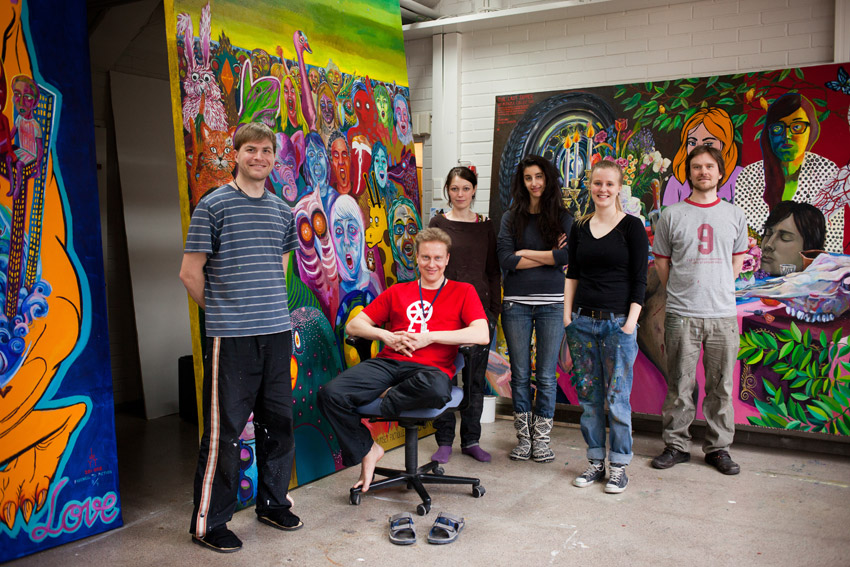|
|
I've made
collective paintings with my fellow artists, with my
students and with groups of teenagers and children.
Started this
practice in 2003.
Click the images to take a
closer look:
|
Collective painters at work
in Dakar, 2012:
The results shown first in Dakar, 2012, then
in Helsinki, 2013:
|
WHAT
IS COLLECTIVE PAINTING?
I've made collective paintings with my fellow
artists, with my students and with groups of
teenagers and children. Started this practice in
2003. I call these group works collective
paintings, because of the democratic and
collaborative nature of the artistic process
that produces them. The group creates the
themes, visual ideas and chooses the styles for
each painting collectively. I'm conducting the
group, but like a leader of a free jazz band
might conduct his/her group so that the other
members of the 'band' retain a high degree of
artistic autonomy and the process of art making
is based on collective, reciprocal exhange.
In addition to guiding the proceedings I also
choose the participants and have the final word
on whether a painting is finished or not.
Sometimes this means that I'm just conducting,
not touching the canvas with my brush at all,
some other times it means that I participate in
'composing' and painting the vision also as a
band member or even as an occasional soloist.
Still the end result is something that
thematically and visually I could never have
done on my own.
Some people would say that strictly speaking
this is not a collective practice, but just
group work similar to what is common in film,
theater and dance, where many people may make an
artistic contribution, but the final product is
usually seen to have just one author – the
director. To some extent I agree, as a method
collective painting resembles a lot some of the
methods used in contemporary dance and theater,
especially the so-called devising method, where
the starting point of a theater/dance play is
not a pre-written script, but the material is
instead created and developed from scratch by
the group during the rehearsals.
However, as in painting the norm is to assume
that paintings are naturally made by single
individuals (much like literature is normally
written solo), I want to stress the fact that
the group work paintings I direct are NOT solo
works, where the participants would be just
helpers executing my orders. Instead, these
works, though directed by me, are real
collaborations.
Nowadays I usually call my collective painting
'band' Perkele Collective. It hasn't got steady
personnel, but I do think its output does have a
clear continuity. Maybe even a direction.
Teemu Mäki,
Helsinki, 14.9.2013
Antidote
7: Collective Painting
(A text that accompanied an
exhibition of collective paintings in 2013:)
"ANTIDOTE is a series of exhibitions and events
of critical art. From Aalto University and
elsewhere. Curated by Teemu Mäki and others."
The seventh ANTIDOTE exhibition is shown at
Gallery Jangva 16.9.–6.10.2013 and it focuses on
collective painting. Collective painting is
something that I have been conducting in
workshops since 2003, usually in museums or
universities. During the last four years mostly
in Aalto University Department of Art, in a
course called Contemporary Art Workshop:
Collective Painting. The exhibition in Jangva
showcases a few of those works and also a work I
made 2012 in Dakar as a part of Dakar Biennale,
with Senegalese artists and art students.
The aim of this exhibition is to show that
painting can be a valid form of critical art.
This fact needs to be emphasized again and
again, because even though painting is generally
accepted as a significant part of contemporary
art – no one is talking about the end or death
of painting – it is not usually perceived to be
a significant form of critical art. Instead, the
focus is on painting's purely aesthetic
potential and on its role as the basic, harmless
currency of the commercial art market. We try to
prove that there's more to painting than that.
The works in the show attempt to be on one hand
directly political – and yet on the other hand
poetic too. "Directly political" here means that
the works tend to have an obvious political
message or position that the viewer can hardly
misunderstand. And "Poetic" here means that we
think the works can simultaneously have other,
equally significant aspects as that blatantly
political, aspects that are ambiguous, open to
many interpretations and escaping literal,
thoroughly verbalized
translation/interpretation. If and hopefully
when the works succeed in this duality, they are
a rich form of critical art: art that on one
hand has a direct and forceful political effect
and on the other hand comes with many layers and
is rich with complex and partly non-verbalizable
meaning.
The most often asked question about the
collective painting method is: "Teemu, what's
your role in this? Who is the real author of
these works?"
The answer is:
"These
are collective works. The ideas, themes, content
and visual decisions come from the whole group
not just from me. I work in this like a
conductor of a jazz band might work; I'm guiding
the process, but the compositions come from the
group and the members of the group have a lot of
freedom, are fairly autonomous in what and how
they actually play, how they interpret the
compositions, the plans the collective has
created. Of course my role is still special, I'm
in charge, I'm the director, responsible for the
whole, as I choose the members to the collective
and in the end I have a final word about whether
a painting is finished or should still be
continued. Yet this doesn't change the fact that
these are real collaborations and collective
efforts. Some of these paintings I've too
touched with my brushes and thus worked side by
side with other painters in addition to
conducting. However, usually I've tried and
managed to stay out of the way and been happy
just to conduct and let others paint."
Teemu Mäki,
Helsinki, 14.6.2013
THE ORIGINS
The first of these collective
paintings was made in 2003, when Virve Sutinen
and Riitta Aarniokoski from Kiasma Theater of
the Contemporary Art Museum in Helsinki asked me
to direct a couple of workshops for children and
teenagers. I thank Virve and Riitta, as without
their initiative none
of these works would exist.
Having never really worked with children I
thought their idea was both ridiculous and
interesting. I led two workshops: the collective
painting workshop and Be
Your Enemy -photo workshop. In
both cases I was so pleased with the results
that I wanted to continue.
Since then I've made numerous
collective paintings with children, teenagers,
amateu and also a couple of collective works
with my fellow professionals – and one with my
daughter, who was 8 at the time.
MORE INFO:
The
Collective Painting as a Combination of
Paedagogy and Making Art
(The following bits are extracts
from The Collective
Painting as a Combination of Paedagogy and
Making Art, which is a chapter in the
essay Toolbox,
included in the written part of my
doctoral thesis: Darkness Visible – Essays on Art,
Philosophy and Politics (2005, English
version 2007).)
In the recent years I have made
large collective paintings with children and
young people. These works have been created in
painting workshops I have taught. The paintings
are made by the collective – not a
hierarchically led team. I feel that those works
partially belong to my oeuvre in the same way as
those theatre productions I have acted in belong
to it. My roles as a teacher and an artists
intermingle in collective painting – and the
outcome is not only painting, but social art as
well. I have used collective painting as a
method of teaching also when I have taught
adults in art schools. It is still exceptional
in painting to work together with one or more
people, but it seems to be growing more common.
It is hard, but within the
limits of possibility, to combine the roles of
an artist, a teacher and an authority, who
“stoops down” to be on the same level as his/her
students. I have tried to succeed in it in
collective painting by creating a set of clear
rules for the event of painting, which are meant
to maintain the collective nature of painting
and to curb my influence especially. The method
has been that first everyone draws a few motifs
in their sketchbooks, anything that is important
to them. The subject can be how difficult it is
to decide which pair of jeans to buy. Or it can
be a concern over the war in Chechnya, the will
to help the people of Chechnya in their struggle
for independence, or the frustration over the
scarcity of the means to help. The subject can
also be the drawer’s joy over mom finding a new
boyfriend.
The next step is to put the
sketches on show for a while. Everyone chooses
one or two favourites among the subjects. Thus
we find the motifs to put into the joint
painting – those that interest most of the
members of the group. We divide the motifs to be
carried out so that each member has to create a
subject someone else has sketched out. This is
the most important insight of the tactic: when
you have to carry out an idea by someone else,
and give your idea into another person’s hands,
reciprocity and trust will become a reality. We
agree on the rough composition of the chosen
motif and get down to painting.
A painter is free in the
collective as well. Painting does not mean
merely carrying out and interpreting motifs that
have been previously sketched in a sketchbook
size. If a completely novel idea emerges during
the painting, the painter can put that into the
work. The division of labour is not strict,
either. In the beginning, while realising the
assigned motif, anyone can add to or modify the
others’ motifs, even without their permission.
The painting is ready when we all agree it is
ready. Naturally the painting is our joint
property also from the point of view of
copyright.
Thus my primary paedagogical
role has been to dictate the above mentioned
rules. I have commented on the students’
decisions during the painting and tried to help
them to achieve the goals they have explained to
me. Sometimes I have also plunged into painting
as one painter among the others, given a few
suggestions of motifs of my own in the
sketchbook phase and realised someone else’s
idea.
...
Collective painting, in which
the teacher participates in the painting, is by
its paedagogical nature the opposite of the
teaching I got in art schools. My teachers
attempted to keep their identities as artists
apart from their role as teachers. A teacher
would almost always use the passive tense,
thereby implicitly representing an objective
authority. We never discussed the teachers’
works with them or in their presence. Even if a
teacher had an exhibition near the school, no
joint excursion was organised there so that the
teacher could have discussed his/her works. The
teachers never used their works, or the problems
that arose in the process of making them, as
examples while teaching. The unspoken assumption
was that if the teacher would mix the roles of
teacher and artist, s/he would be pressing
his/her own concept of art on the students – and
that would have been immoral brainwashing. Being
a teacher myself now, I disagree with that
notion. I think keeping one’s own identity as an
artist in open view is what makes teaching art
understandable and holistic, as well as gives
the students a chance to consider their
teacher’s ideas as just another possibility.
Collective painting is a method
with its own ideological content. I am not
naively claiming that painting alone would
represent individualism and painting
collectively would represent a more communal
outlook on human existence. Individualism,
extreme individualism even, exists in all art I
have made alone or in a group. Individualism
means making art for yourself, being
systematically indifferent to what the audience
hopes and expects. You can make art for yourself
even in a group; painting collectively does not
mean submitting to the public opinion, the
dictatorship of the lowest common denominator.
However, some people have suspected that the
method of collective painting stifles the
individuality of the participants. One
exhibition goer stopped to watch our work shop
efforts in Kiasma in 2004 and said: What’s this?
We have a fucking Maoist workers’ brigade
painting here with their hands tied together,
and they claim it’s about important common
issues?
In collective working the group
only has to agree in the beginning and only
about the method. Before painting, the group has
to agree on the rules together and decide when
the painting stops, when the work is ready. In
all other stages everyone will decide themselves
what they do, based on the stimuli offered by
the others. During the process of painting
everyone gets to paint in the way they want, but
they cannot protect the parts they have painted
from the touch of the others. Collective
painting does not mean giving up the individual
self-expression – just private ownership.
In collective painting
workshops people usually paint better pictures
than on their own. When they paint alone their
will to make it “finished and controlled” blocks
their skills of making it versatile and honest.
When they paint alone they are distressingly
aware of being held responsible of the outcome
all by themselves. That is why self-censorship
and prudishness take over. Collective painting
is an antidote to this. It is vital that in
collective painting no one controls the whole,
no leading individual, but not the consensus of
the collective either. This does not mean chaos
or randomness, but that every participant must
accept the conflictuality of the outcome or at
least tolerate it. One has to give up the ideal
of a “controlled whole” during the making of the
painting and while looking at it.
What does it mean to give up
the ideal of a controlled whole? It makes it
easier to deal with painful, unclear topics, of
which the maker or makers have profoundly
contradictory views. With profound
contradictions I mean an irreconcilable conflict
that cannot be packed in the form of thesis and
anti-thesis, from which we can then squeeze a
synthesis. An irreconcilable conflict is also
something that does not fit into the format of
the sonata, which requires extreme consistency
and a resolution that pacifies the themes. The
collective painting I suggest – and its musical
correspondents, like free improvisation and free
jazz – are methods of creating, which already as
such embody worldviews and outlooks on human
existence that renounce simple “good versus
evil” dichotomies and instead stress the
permanent moral conflicts of existence. These
ways of thinking allow one to experience the
partially uncontrolled and imperfect structures
as true and vivid.
Why is painting still almost
exclusively a solo genre? It is not an adequate
explanation to say that people who are solistic
and introverted choose painting or writing,
while the social babblers, who love to be in a
crowd go into theatre or cinema. This division –
albeit partially true – is a consequence of the
existing practices, not of the innate
characteristics of these ways of expression.
Several painters can easily
bustle in front of a painting simultaneously. On
the painting their expressions fluently overlap,
interlock or dissolve together. Writing, another
art which has stayed almost exclusively a solo
act, is different in this sense. It is possible
to write together – one day it may become an
even bigger phenomena than writing alone – but
putting the text together as a pile of sheets
that has a locked chronological order requires
reaching an absolute consensus of a sort.
Hypertexts with multiple paths could be a route
to a more flexible literary teamwork. However,
the hypertexts do not change the fact that
literary texts are usually narratives that
operate with fixed characters and which are
built on causality. Writing it as a joined
effort requires great unanimity and careful
maintenance of the story’s inner logic.
Collective painting is free from this burden.
In many arts nowdays the
structure of the artistic work process and team
is becoming less hierarchical. In theatre, the
positions of the text and director as the
biggest authorities have been denied for a long
time. Painting as a team effort and
collectivising it have been long in coming.
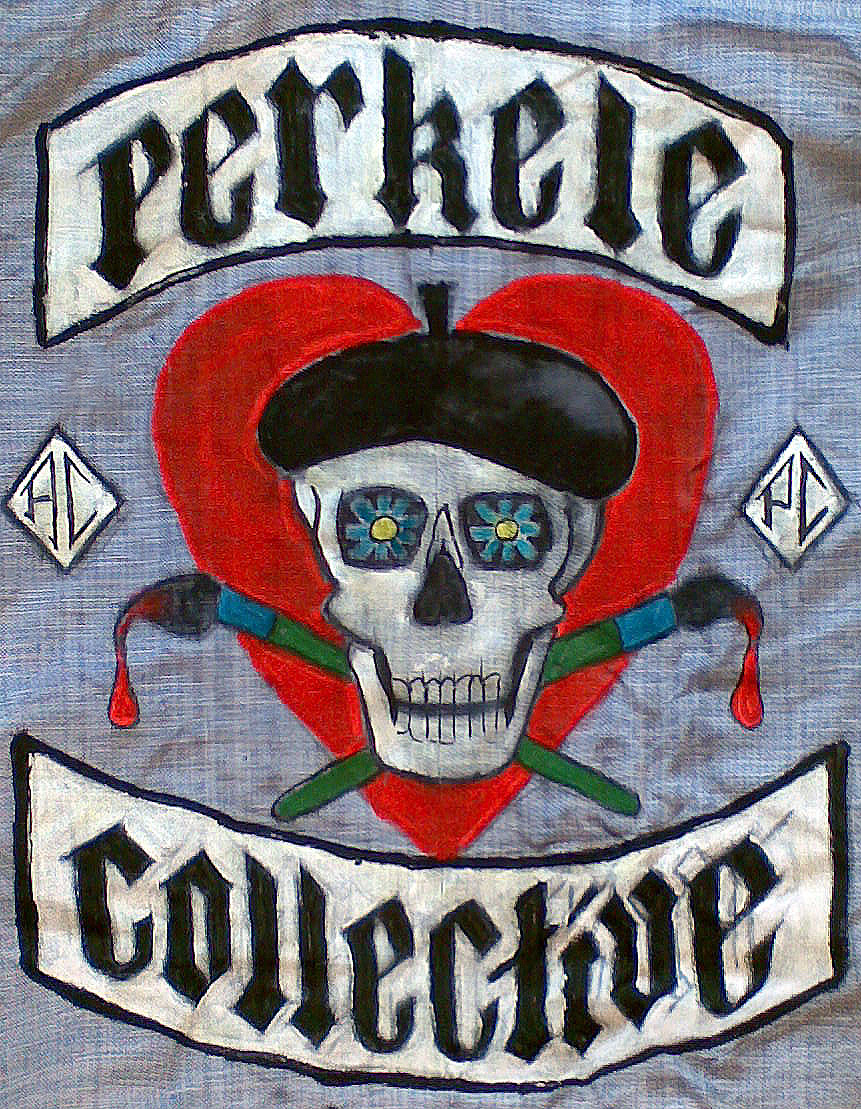 The abominable PERKELE
COLLECTIVE (AC/PC, Art Club Perkele
Collective) vest patch, design by Sampsa
Indrén.
The abominable PERKELE
COLLECTIVE (AC/PC, Art Club Perkele
Collective) vest patch, design by Sampsa
Indrén.
|
Exhibition views
of collective paintings:
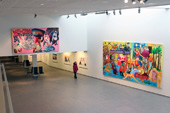

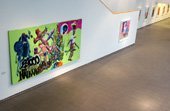

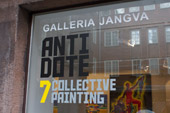
|
